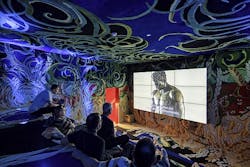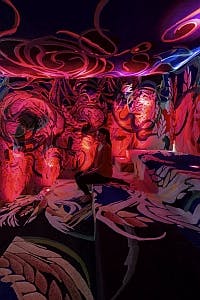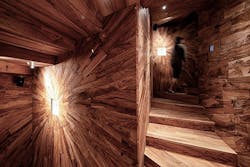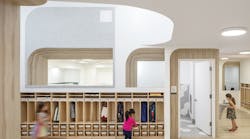Situated in the old Kvarner Palace in Mali Lošinj, Croatia, the new Muzej Apoksiomena has been designed to tell the story of the Croatian-discovered Greek athlete called Apoxyomenos. Zumtobel supplied the LED-based lighting for the museum working with Croatian architects Idis Turato and Saša Randić, who were charged with designing the museum to bring the story of the Apoxyomenos statue to life. The team used various solid-state lighting (SSL) products to guide guests along the journey and culminated the experience with white, shadow-free lighting on the statue that reveals intricate details of the once-lost art, as shown in Fig. 1.
We have written quite a lot about LED lighting used in museums and with iconic works of art. Several years back, we covered the relighting of the Rijksmuseum in the Netherlands, which was undertaken with LEDs both for energy efficiency and to better reveal colors in the paintings. In other instances, LED lighting has been specified primarily to minimize damage to artwork from light exposure such as at the Getty Museum in Los Angeles. The Muzej Apoksiomena is different in that the SSL scheme was developed to help tell a story and set a theme, as the remaining photos will demonstrate.
The statue of Apoxyomenos was discovered by amateur divers off the coast of the island of Lošinj back in 1996. The approximately 2000-year-old bronze work was partially buried in sand on the floor of the Mediterranean Sea. It’s not known for certain how the statue came to rest in the sea but is suspected that it was thrown into the sea from a Roman merchant ship during a storm between 20 BC and 110 AD. The extremely rare discovery of an ancient work of art resulted in its recovery some three years later, and the statue started on the path toward its display in a dedicated museum.
The architects customized the building housing the statue inside and out to tell a story. The design utilizes a glass roof structure and features a large balcony. The team used Ikono wall luminaires and floor-recessed Paso II RGB luminaires to bathe the surfaces in color during the evening. Architect Turato describes the concept as “like in scenes from a Stanley Kubrick film, visitors experience a museum that unfolds in rhythmic sections in front of their very eyes.”
Upon entry to the museum, visitors first experience a chamber with cobalt-blue walls intended to evoke the concept of a seabed. A white steel structure floats above the chamber like the hull of a ship. All of the light sources are hidden from view.
Visitors then ascend in a hidden escalator to an exhibition space where the history of the statue is revealed. In that space, lighting comes primarily via backlit panels and tables, providing soft light for the exhibits that tell the story.
Next, visitors proceed to a cinema area to view a video on the history of the statue (Fig. 2). But still the aquatic theme is continued. The architects said floor-recessed Paso II RGB luminaires evoke a murky subaquatic atmosphere with flowing color transitions. That impact is supported by images of aquatic plants and floral patterns on wall and ceiling surfaces (Fig. 2 inset).
FIG. 2. Unlike the subtle exterior lighting, the interior of the museum features bolder SSL application meant to evoke the sea (inset), including in the cinema room where architectural surfaces and dynamic lighting evoke aquatic life while visitors learn about the history of the statue (main).
The visitors then enter the media room via a red staircase and encounter the statue for the first time from below, looking up through an opening in the ceiling. The room design is intended to share with visitors how the story of Apoxyomenos has been reported around the world.
Finally, visitors ascend a wood staircase with olive-wood surfaces that appears to give the impression of rising from the sea (Fig. 3). Small chambers recessed in the walls showcase items such as branches, herb seeds, and olive stones originally found inside the statue on the seabed. Those objects are lit with the miniature Microtools SSL system.
FIG. 3. Nearing the chamber that houses Apoxyomenos, visitors climb a staircase, leaving an underwater theme, and have a chance to view various LED-highlighted objects that were found inside the statue on the seabed.
At the top of the meandering wood staircase, the visitor arrives in the stark white chamber where the 1.92m-high Greek athlete is the center of attention (refer back to Fig. 1). The combination of white floor tiles and a white textile surface on the walls evokes an almost dimensionless space.
Of course, it was a challenge to design the space in a manner in which there were no light sources evident and in which there is perfect visibility of the subtleties of the statue — yet no shadows distract the observers in the space. The designers utilized Cielos planar luminaires to shroud the room. Moreover, linear LED strips were placed in the spaces between the Cielos rectilinear fixtures to eliminate any discernable gaps, with all of the lighting diffused by the textiles.
The overall design even affords the visitors the opportunity to unwind, so to speak. Leaving the main chamber, visitors reach the glass roof structure and experience views of the bay of Mali Lošinj.
Ultimately, the designers delivered a project with spatial content. The concept mirrors the emergence of the lost statue from the seabed to a spot almost basking in the perfect light of the sun.








